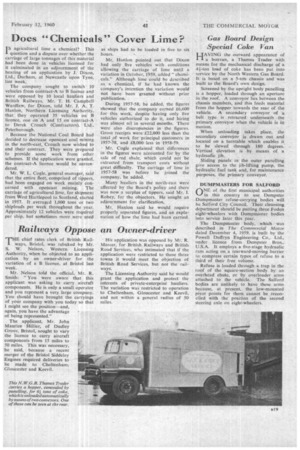Does "Chemicals" Cover Lime?
Page 53

If you've noticed an error in this article please click here to report it so we can fix it.
I S agricultural lime a chemical? This question and a dispute over whether the carriage of large tonnages of this material had been done in vehicles licensed for it culminated in an adjournment of the hearing of an application by J. Dixon, Ltd., Durham, at Newcastle upon Tyne, last week. The company sought to switch 10 vehicles from contract-A to B licence and were opposed by 10 local hauliers and British Railways. Mr. T; H. Campbell Wardlaw, for Dixon, told Mr. J. A. T. Hanlon, Northern Licensing Authority, that they operated 35 vehicles on B licence, one on A and 15 on contract-A to Derek Crouch (Contractors). Ltd.. Peterborough. Because the National Coal Board had decided to decrease opencast coal mining in the north-east, Crouch now wished to end their contract. They were prepared to provide some work from other schemes. If the application were granted, the contract-A licence would be surrendered. . Mr. W. L. Cogle, general manager, said that the entire fleet, comprised of tippers, had been engaged on work mainly concerned with opencast mining. The carriage of agricultural lime, for shipment from West Hartlepool to Scotland, started in 1957. it averaged 1,000 tons or two shiploads per week throughout the year. Approximately 12 vehicles were required per ship, but sometimes more were used
as ships had to be loaded in five to six hours.
Mr. Hanlon pointed out that Dixon had only five vehicles with conditions allowing the carriage of lime until a variation in October, 1959, added "chemicals." Although lime could be described as a chemical, if he had known the company's intention the variation would not have been granted without prior publication. During 1957-58, he added, the figures showed that the company earned £6,600 for this work, despite having only five vehicles authorized to do it, and hiring was almost nil in several months. There were also discrepancies in the figures. Gross receipts were £22,000 less than the total of work for principal customers in 1957:58, and £8,000 less in 1958-59. • Mr. Cogle explained that differences in the figures were accounted for by the sale of red shale, which could not be extracted from transport costs without great difficulty. The carriage of lime in 1957-58 was before he joined the company, he added. Many hauliers in the north-east were affected by the Board's policy and there was now a surplus of tippers, said Mr. Robey, for the objectors. He sought an adjournment for clarification. Mr. Hanlon said he would require properly separated figures, and an explanation of how the lime had been carried.




















































































































